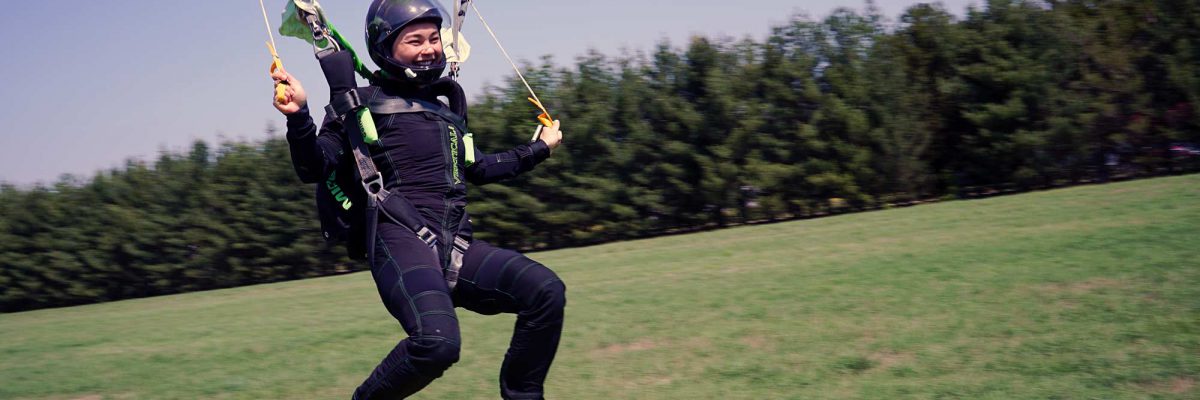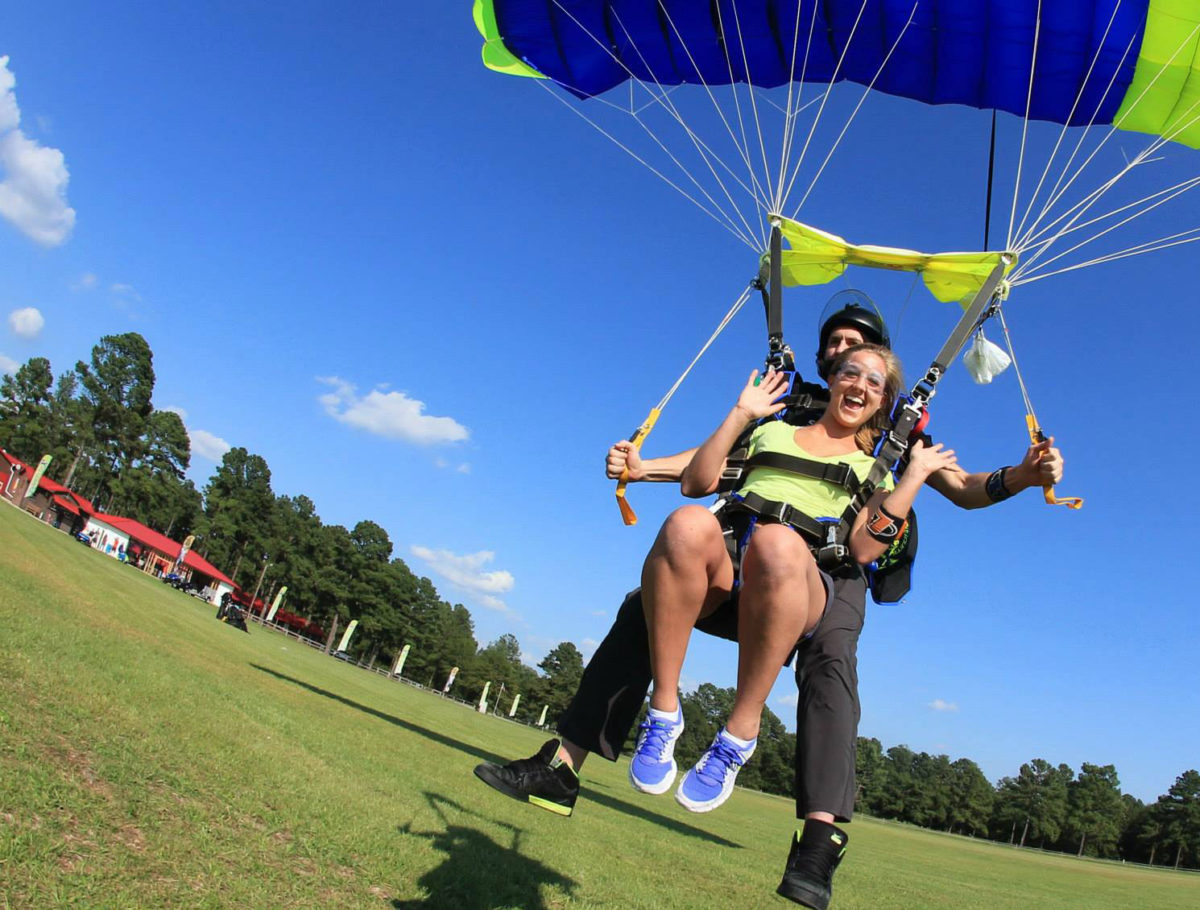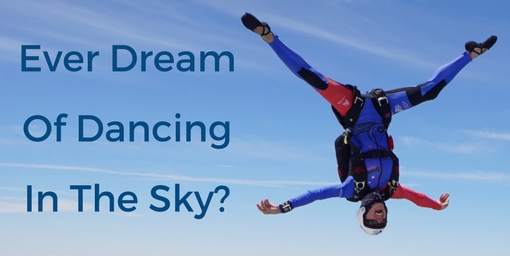
5 Steps to Master Solo and Tandem Skydiving Landings
Wednesday, August 19, 2020
- Team FlyXP
- 8/19/20
- 0
- General
The thrill of jumping from a plane is a dream for many – the exhilarating leap from the door, the rush of freefall, and the tranquil canopy flight. However, landing while skydiving is often a concern for people. When you’re new, most of this incredible sport is a mystery. So let us help you unveil a few skydiving landing tips for both our tandem skydiving students and solo skydiving jumpers.
The Tandem Skydiving Landing Tips
A tandem skydive is simply a new skydiving student harnessed to the front of an experienced and certified instructor who wears a dual parachute system built for two. When landing, it is easy for all the legs to get tangled or do opposite things at the same time, so here’s how you and your instructor have a smooth landing:
Put the old skydiving movies to rest
We are so fortunate to have the opportunity to showcase skydiving in its greatest light with the development of social media. However, back in the day, many military parachutists who wore calf high boots and jumped round parachutes came in like a heavy load tumbling toward the ground. Old movies portray a similar picture. But skydiving has come a long way with technology, equipment and training techniques. You can shelve the old school skydiving movies and be amazed by what skydivers are capable of with modern parachutes.
Know Where You’re Going
It is a common misconception that parachutes descend straight down. With today’s modern parachutes, we have the capability of great control and maneuverability that can land us on point! These modern parachute designs are what is called, ram air – which is the principle of using airflow to increase pressure. The ram air parachute is inflated by the wind and propels the parachute in a forward glide back to earth. And how long does it take to fly the parachute back to earth? About five to seven minutes.
Lift Your Legs
Okay, a lot of design concepts here, but stick with us! The ram air principle is important to remember. Since parachutes have forward momentum, we must look toward an intended landing point and keep our legs and feet lifted upon landing – specifically for the tandem skydiving landing.

It is common to want to reach your feet down in anticipation of the ground coming up. However, if you reach down before the parachute has come to a stop, then you will most likely stop, and the parachute will keep moving forward and you just may plop on your belly! Or you and your instructor may tangle up your legs as you each try to touch down.
Therefore, it is incredibly important to trust your instructor, lift your legs for landing so they may control the parachute, read the descent and speed, and touch down for a smooth landing.
Prepare to Butt Slide
Yeah, butt slides don’t sound fun but a slide-in landing is more ideal than tripping over each other on a tandem skydiving landing! We like to say prepare for a butt slide and bonus points if you stand up!
Listen to Your Instructor
We have this guide to help you understand how to do a tandem skydiving landing, but your instructor has the final authority in preparing you for the skydiving landing. So please listen!
Solo Skydiving Landing Tips
These skydiving landing tips are vastly different from tandem skydiving landings. For one, more training has been invested to fly solo and you don’t have an instructor harnessed to you. Next, the parachute size, controllability, and landing pattern will vary from a tandem landing to a solo skydiving landing. So this section addresses those in the solo freefall program or newly licensed skydivers here. However, those with more experience can also utilize these solo skydiving landing tips, too!
Fly Smooth
When flying the parachute, use predictable and smooth inputs so others can easily follow and understand your intentions in the landing pattern. This will set you up for success, as you will have a stable wing configuration as you prepare to land.
Look Ahead
By this point in your skydiving career, you may have heard your instructors encourage and teach you to look up ahead (not down) at about a 45° angle towards where the intended landing point is, to help you gauge when to flare (or slow) the parachute for landing. This is because of the ram air principle we talked about in the Tandem Skydiving Landing Tip No. 2 above!
Flare Evenly
Wherever your eyes look, you will subconsciously fly in that direction and sometimes that means one hand lowers more than the other side. What happens when one toggle is pulled slightly lower than the other side? A turn. So this is an important one: Look ahead at your intended landing point and bring both steering toggles down together evenly for a smooth landing flare of the parachute.
PLF
The PLF stands for Parachute Landing Fall. The PLF has been around for so long, has not been updated, and is still applicable to this day! If a landing isn’t going as planned, then a PLF is desired. The landing technique taught in the Paraclete Student Program (PSP) helps distribute the impact of the fall to protect you.
Be Open to Continue to Learn
Whether you are still in the PSP Program, newly licensed, not standing up your landings, or rocking them all, there’s always something new to learn to be more comfortable and confident in your skydiving landings. There are several opportunities to learn from world renowned coaches here at Skydive Paraclete XP. Stay updated on our Facebook event page for more information.
Skydive Paraclete XP boasts some of the greatest facilities for all types of skydivers, drawing in many canopy pilots from around the world to enjoy our swoop pond. It’s exciting to watch and thrilling to perform. There are many steps to become a proficient canopy pilot and we hope that these skydiving landing tips will help you in your journey.
If you’re ready to take the next step and make your first tandem skydive, contact us and we’ll be happy to welcome you!
Copyright © 2025, Skydive Paraclete XP, All Rights Reserved.
DropZone Web Design & Marketing by Beyond Marketing, LLC
